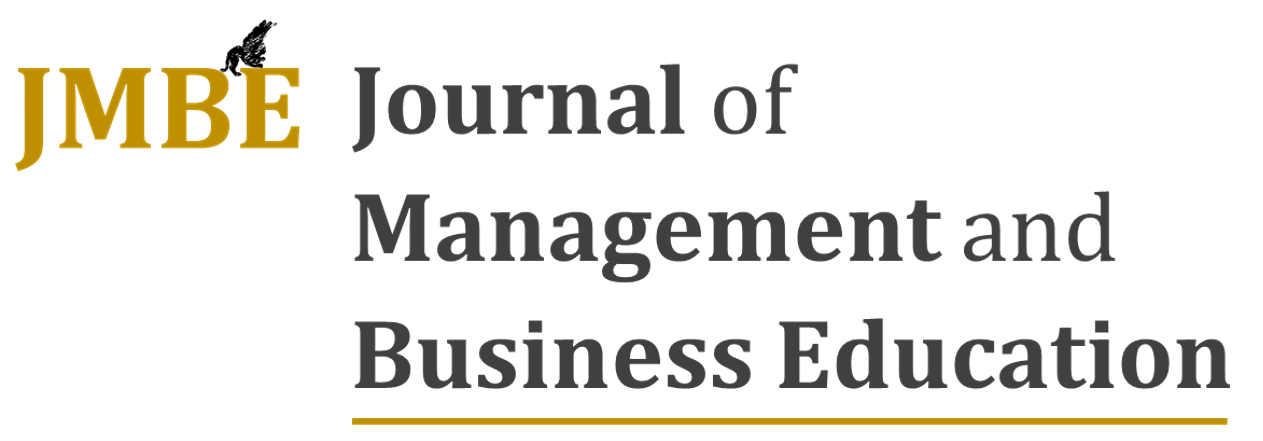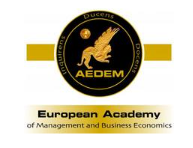Game of thrones in class. Effect of gamification on amotivation and perceived quality
DOI:
https://doi.org/10.35564/jmbe.2020.0006Keywords:
gamification, amotivation, service quality perception, teaching qualityAbstract
The loss of students’ motivation (amotivation) is among the most important problems in academic centers. Nowadays, it is still unknown if gamification diminish the loss of students’ motivation and if it affects the perception of the teaching quality in the classroom. This paper develops an exploratory investigation based on a sample of 57 students, from two subjects, from two different degrees, to analyze whether gamification influences motivation and the perception of the teaching quality in the classroom. Results show that gamification not always reduce amotivation and it may even cause an increase in amotivation. Moreover, the influence of gamification depends, among other possible factors, on the teacher, also, gamification has no influence on the teaching quality perception in the classroom. These results open important research lines for future works.
Downloads
References
Bedoya Mejía, K. Y; Rodríguez González, M. S. L; Ramírez, S. (2015). “Relación entre la motivación académica y el rendimiento escolar de los estudiantes de bachillerato en extra-edad de un Colegio Colombiano”, Tecnológico de Monterrey.
https://doi.org/10.35537/10915/59220
Bicen, H; Kocakoyun, S. (2018). “Perceptions of students for gamification approach: Kahoot as a case study”, International Journal of Emerging Technologies in Learning (iJET), Vol. 13, No. 02, pp. 72-93.
https://doi.org/10.3991/ijet.v13i02.7467
Brunvand, S; Hill, D. (2019). “Gamifying your Teaching: Guidelines for Integrating Gameful Learning in the Classroom”, College Teaching, Vol. 67, No. 1, pp. 58-69.
https://doi.org/10.1080/87567555.2018.1518893
Dawar, N; Pillutla, M. M. (2000). “Impact of product-harm crises on brand equity: The moderating role of consumer expectations”, Journal of Marketing Research, Vol. 37, No. 2, pp. 215-226.
https://doi.org/10.1509/jmkr.37.2.215.18729
de Sousa Borges, S; Durelli, V. H; Reis, H. M; Isotani, S. (2014, March). “A systematic mapping on gamification applied to education”. In Proceedings of the 29th Annual ACM Symposium on Applied Computing (pp. 216-222). ACM.
https://doi.org/10.1145/2554850.2554956
Dean, A. M. (2004). “Rethinking customer expectations of service quality: are call centers different?”, Journal of Services Marketing, Vol. 18, No. 1, pp. 60-78.
https://doi.org/10.1108/08876040410520717
Deci, E. L; Ryan, R. M (2000). The" what" and" why" of goal pursuits: Human needs and the self-determination of behavior. Psychological inquiry, Vol. 11, No. 4, pp. 227-268.
https://doi.org/10.1207/s15327965pli1104_01
Deterding, S; Sicart, M; Nacke, L; O'Hara, K; Dixon, D. (2011). Gamification. Using game-design elements in non-gaming contexts. In CHI'11 extended abstracts on human factors in computing systems, 2425-2428, ACM.
https://doi.org/10.1145/1979742.1979575
Dicheva, D; Dichev, C; Agre, G; Angelova, G. (2015). “Gamification in education: A systematic mapping study”, Journal of Educational Technology y Society, Vol. 18, No. 3, pp. 75-88.
Escapa, M; González, M; Lucas, J. (2015). “Aprendizaje basado en juegos de rol: el Juego de la Negociación Climática”, VI Jornadas de Docencia en Economía. Bilbao.
https://doi.org/10.14201/gredos.129403
Fernández Gavira, J. F; Prieto Gallego, E. P; Alcaraz-Rodríguez, V. A; Alcaraz-Rodríguez, A. J. S; Grimaldi-Puyana, M. G. (2018). “Aprendizajes Significativos mediante la Gamificación a partir del Juego de Rol: “Las Aldeas de la Historia””, Espiral. Cuadernos del Profesorado, Vol. 11, No. 22, pp. 69-78.
https://doi.org/10.25115/ecp.v11i21.1919
Golder, P. N; Mitra, D; Moorman, C. (2012). “What is quality? An integrative framework of processes and states”, Journal of Marketing, Vol. 76, No. 4, pp. 1-23.
https://doi.org/10.1509/jm.09.0416
Gonzalez Menorca, C; Pelegrín Borondo, J. (2014). “Nuevas herramientas para la gestión de la calidad de servicio en el aula”. En Menorca, Gonzalez Menorca, L. y Navaridas Nalda, F. (coord.). Acción pedagógica en los centros escolares: Enfoque teórico y práctico (pp. 117-134). Fundación Universidad de La Rioja: Logroño.
https://doi.org/10.5176/2251-2349_hrmpd17.30
Hamari, J; Koivisto, J; Sarsa, H. (2014, January). “Does gamification work?--a literature review of empirical studies on gamification”. In 2014 47th Hawaii international conference on system sciences (HICSS) (pp. 3025-3034). IEEE.
https://doi.org/10.1109/hicss.2014.377
Hamer, L. O; Liu, B. S. C; Sudharshan, D. (1999). “The effects of intraencounter changes in expectations on perceived service quality models”, Journal of Service Research, Vol. 1, No. 3, pp. 275-289.
https://doi.org/10.1177/109467059913008
Higgs, B; Polonsky, M. J; Hollick, M. (2005). “Measuring expectations: forecast vs. ideal expectations. Does it really matter?”, Journal of retailing and consumer services, Vol. 12, No. 1, pp. 49-64.
https://doi.org/10.1016/j.jretconser.2004.02.002
Hunicke, R; LeBlanc, M; Zubek, R. (2004, July). “MDA: A formal approach to game design and game research”. In Proceedings of the AAAI Workshop on Challenges in Game AI (Vol. 4, No. 1, p. 1722).
Kumar, P; Kalwani, M. U; Dada, M. (1997). “The impact of waiting time guarantees on customers' waiting experiences”, Marketing Science, Vol. 16, No. 4, pp. 295-314.
https://doi.org/10.1287/mksc.16.4.295
Lee, J. J; Hammer, J. (2011). “Gamification in education: What, how, why bother?”, Academic Exchange Quarterly, Vol. 15, No. 2, pp. 146-151.
Levin, R.I; Rubin, D. (1996). Estadística para administradores. Pretice Hall, Mexico.
Manassero Mas, A. M., & Vázquez Alonso, A. (2000). Análisis empírico de dos escalas de motivación escolar. Revista electrónica de motivación y emoción, 3(5-6).
Medrano, N., Olarte-Pascual, C., Pelegrín-Borondo, J., y Sierra-Murillo, Y. (2016). “Consumer behavior in shopping streets: the importance of the salesperson's professional personal attention”, Frontiers in Psychology, Vol. 7, No. 125.
https://doi.org/10.3389/fpsyg.2016.00125
Mitra, D; Fay, S. (2010). “Managing service expectations in online markets: A signaling theory of e-tailer pricing and empirical tests”, Journal of Retailing, Vol. 86, No. 2, pp. 184-199.
https://doi.org/10.1016/j.jretai.2010.02.003
Montgomery, S; Gregg, D. H; Somers, C. L; Pernice-Duca, F; Hoffman, A; y Beeghly, M. (2019). “Intrapersonal Variables Associated with Academic Adjustment in United States College Students”, Current Psychology, Vol. 38, No. 1, pp. 40-49.
https://doi.org/10.1007/s12144-016-9533-0
Nah, F. F. H; Zeng, Q; Telaprolu, V. R; Ayyappa, A. P; Eschenbrenner, B. (2014, June). “Gamification of education: a review of literature. In International conference on HCI in business” (pp. 401-409). Springer, Cham.
https://doi.org/10.1007/978-3-319-07293-7_39
Noyens, D; Donche, V; Coertjens, L; van Daal, T; Van Petegem, P. (2019). “The directional links between students’ academic motivation and social integration during the first year of higher education”, European Journal of Psychology of Education, Vol. 34, No. 1, pp. 67-86
https://doi.org/10.1007/s10212-017-0365-6
Núñez, J. L; Martín-Albo, J; Navarro, J. G. (2005). Validación de la versión española de la Échelle de Motivation en Éducation. Psicothema, Vol. 17, No. 2, 344-349.
Nuñez Alonso, N., Martín-Albo Lucas, L., Navarro Izquierdo, J. G., Grijalvo Lobera, F. (2006). Validación de la escala de motivación educativa (EME) en Paraguay. Interamerican Journal of Psychology. Vol. 40, No. 3, pp. 1-8.
https://doi.org/10.1037/t71625-000
Oliver, R. L; Winer, R. S. (1987). “A framework for the formation and structure of consumer expectations: Review and propositions”, Journal of Economic Psychology, Vol. 8, No. 4, pp. 469-499.
https://doi.org/10.1016/0167-4870(87)90037-7
Parasuraman, A. (2011). “Some reflections on my career, publishing, and contributing significantly to a field: cómo publicar y contribuir de modo significativo en un campo del conocimiento”, Innovar, Vol. 21, No. 42, pp. 5-16.
Parasuraman, A; Berry, L. L; Zeithaml, V. A. (1991). “Refinement and reassessment of the SERVQUAL scale”, Journal of Retailing, Vol. 67, No. 4, pp. 420-450.
Parasuraman, A; Zeithaml, V. A; Berry, L. L. (1988). “Servqual: A multiple-item scale for measuring consumer perc”, Journal of Retailing, Vol. 64, No. 1, pp. 12-40.
Pelegrín-Borondo, J; Ayensa, E. J; Olarte-Pascual, C; Sierra-Murillo, Y. (2016). “Diez tipos de expectativas”, Revista Perspectiva Empresarial ISSN: 2389-8194 (En línea), Vol. 3, No. 1, pp. 109-124.
https://doi.org/10.16967/rpe.v3n1a7
Potdevin, F; Vors, O; Huchez, A; Lamour, M; Davids, K; Schnitzler, C. (2018). “How can video feedback be used in physical education to support novice learning in gymnastics? Effects on motor learning, self-assessment and motivation”, Physical Education and Sport Pedagogy, Vol. 23, No. 6, pp. 559-574.
https://doi.org/10.1080/17408989.2018.1485138
Ramesh, A; Sadashiv, G. (2019). “Essentials of Gamification in Education: A Game-Based Learning”. In Research into Design for a Connected World (pp. 975-988). Springer, Singapore.
Raftopoulos, M (2014). Towards gamification transparency: A conceptual framework for the development of responsible gamified enterprise systems. Journal of Gaming & Virtual Worlds, Vol. 6 No. 2, pp. 159-178.
https://doi.org/10.1386/jgvw.6.2.159_1
Stodnick, M; Rogers, P. (2008). “Using SERVQUAL to measure the quality of the classroom experience”, Decision Sciences Journal of Innovative Education, Vol. 6 No. 1, pp. 115-133.
https://doi.org/10.1111/j.1540-4609.2007.00162.x
Vallerand, R. J; Pelletier, L. G; Blais, M. R; Briere, N. M; Senecal, C; Vallieres, E. F. (1992). The Academic Motivation Scale: A measure of intrinsic, extrinsic, and amotivation in education. Educational and psychological measurement, Vol. 52, No. 4, pp. 1003-1017.
https://doi.org/10.1177/0013164492052004025
Vallerand, R. J; Fortier, M. S; Guay, F. (1997). “Self-determination and persistence in a real-life setting: toward a motivational model of high school dropout”, Journal of Personality and Social Psychology, Vol. 72, No. 5, pp. 1161. –1176.
https://doi.org/10.1037/0022-3514.72.5.1161
Vallerand, R.J. (1997). “Toward a hierarchical model of intrinsic and extrinsic motivation”. En M. Zanna (Ed.): Advances in Experimental Social Psychology, Vol. 29, pp. 271-360. Toronto: Academic Press.
https://doi.org/10.1016/s0065-2601(08)60019-2
Vallerand, R.J; Blais, M.R; Brière, N.M; Pelletier, L.G. (1989). “Construction et validation de l’Échelle de Motivation en Éducation (EME)”, Canadian Journal of Behavioral Sciences No. 21, 323-349.
https://doi.org/10.1037/h0079855
Volpi, V; Parente, G. A; Pifferi, G; Opromolla, A; Medaglia, C. M. (2018, July). “Improving Quality of Interaction with the Mobility Services Through the Gamification Approach”, In International Conference on Human-Computer Interaction (pp. 488-502). Springer, Cham.
https://doi.org/10.1007/978-3-319-91250-9_38
Yip, J;Chan, H. H; Kwan, B; Law, D. (2011). “Influence of appearance orientation, BI and purchase intention on customer expectations of service quality in Hong Kong intimate apparel retailing”, Total Quality Management y Business Excellence, Vol. 22, No. 10, pp. 1105-1118.
https://doi.org/10.1080/14783363.2011.593904
Yuan, Y; Qi, K. K; Marcus, A. (2017, September). “Gamifying HPE Service Manager to Improve IT Service Desks' Knowledge Contribution”. In Proceedings of the 10th EAI International Conference on Simulation Tools and Techniques (pp. 141-148). ACM.
https://doi.org/10.1145/3173519.3173536
Zeithaml, V. A. (1988). 2Consumer perceptions of price, quality, and value: a means-end model and synthesis of evidence”, Journal of Marketing, Vol. 52, No. 3, pp. 2-22.
https://doi.org/10.1177/002224298805200302
Zeithaml, V. A; Berry, L. L; Parasuraman, A. (1993). “The nature and determinants of customer expectations of service”, Journal of the Academy of Marketing Science, Vol. 21, No. 1, pp. 1-12.
Downloads
Published
How to Cite
Issue
Section
License
Copyright (c) 2023 Journal of Management and Business Education

This work is licensed under a Creative Commons Attribution-NonCommercial-ShareAlike 4.0 International License.
License terms at: https://creativecommons.org/licenses/by-nc/4.0/legalcode




